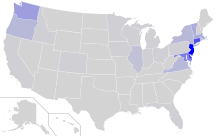Estonian Americans
This articleneeds additional citations forverification.(February 2023) |
Ameerika eestlased(Estonian) | |
|---|---|
 | |
| Total population | |
| 29,128(2021)[1] 0.01% of the US population | |
| Regions with significant populations | |
| California·New York·New Jersey·Washington·Florida·Oregon | |
| Languages | |
| American English,Estonian | |
| Religion | |
| Protestant(Lutheran),Deism | |
| Related ethnic groups | |
| Estonian Canadians,Finnish Americans,Latvian Americans,Lithuanian Americans |
Estonian Americans(Estonian:Ameerika eestlased) areAmericanswho are ofEstonianancestry, mainly descendants of people who leftEstoniabefore and especially duringWorld War II.According to the 2021American Community Survey,around 29,000 Americans reported full or partial Estonian ancestry,[1]up from 26,762 in1990.
History
[edit]| Estonian-American population as of the 2000 U.S. census[2] | |
|---|---|
| California | 3,465 |
| New York | 2,892 |
| New Jersey | 2,331 |
| Washington | 1,401 |
| Florida | 1,393 |
The first recorded arrival of immigrants from Estonia (then part of Sweden) to what is now the United States occurred already in 1627 in the colony ofNew Swedenalong theDelaware River.Emigration from Estonia started on a larger scale in the late 19th century, when Estonia was part of the formerRussian Empire,and continued until the mid-20th century. However, it is difficult to estimate the number of Estonian-Americans before 1920, since they were often referred to as "Russians" in the national censuses.[3]
The beginnings ofindustrializationand commercial agriculture in the Russian Empire transformed many Estonian farmers into migrants. The pressures of industrialization drove numerous Estonian farmers to emigrate to the United States until Estonia became an independent country in 1918, at the end of World War I.
During World War II, Estonia was invaded and occupied by the Soviet Union in 1940–1941, and by Nazi Germany in 1941–1944. In 1944, in the face of the country being re-occupied by the Soviet Red Army, 80,000 people fled from Estonia by sea to Germany and Sweden, becomingwar refugeesand later,expatriates.
Some thousand of them moved on from there and settled in the United States. After the war's end, thesedisplaced personswere allowed to immigrate to the United States and to apply forcitizenship.In 1948, theDisplaced Persons ActfromU.S. Congressstipulated that 40% of the available visas go to “Baltic”people (Estonians,Latvians,andLithuanians). This act and its 1950 revision allowed 11,000 Estonians into the United States between 1948 and 1952.[3]Some of these refugees and their descendants started returning to Estonia at the end of the 1980s.
Notable people
[edit]PresidentFranklin Delano Rooseveltdescended from 17th-centuryTallinnercolonists inNew Amsterdam.[4]
ConductorNeeme Järviwas the music director of theDetroit Symphony Orchestra,theNew Jersey Symphony Orchestra,as well as the internationalGothenburg Symphony,andHet Residentie OrkestofThe Hague.His three children, conductorsPaavo JärviandKristjan Järvi,and flutist Maarika Järvi, are prominent American musicians in their own right. Paavo Järvi is the chief conductor of theCincinnati Symphony Orchestra.
ChemistLauri Vaskaemigrated to United States in 1949. He is distinguished for his research inorganometallic chemistry,winning the prestigiousBoris Pregel Award.Hillar Rootare,a materials scientist, is best known for his work in the development of mercuryporosimetry,high pressure liquidchromatography,and the formulation of theRootare-Prenzlow Equation.
In journalism,Edmund S. Valtman,a successful editorial cartoonist, won thePulitzer Prize for Editorial Cartooning.
Ene Riisnais an Estonian-born American award-winning television producer, known for her work on the American news program20/20.
Alar Toomreis an astronomer recognized for his research on the dynamics of galaxies. TheToomre sequenceandToomre Instabilityare named in his honor.
In entertainment, singer and actressMiliza Korjuswas nominated for anAcademy Awardfor her performance in the 1938 filmThe Great Waltz.
Hollywood actorJohann Urb(born January 24, 1977) is an Estonian living and working in the United States.
Kerli Kõiv(born February 7, 1987), better known mononymously as Kerli, is an Estonian pop singer residing in the United States since 2005.
Psychologist, psychobiologist and neuroscientistJaak Panksepp(June 5, 1943 — April 18, 2017) coined the term 'affective neuroscience', the name for the field that studies the neural mechanisms of emotion.
Mena Suvari(born February 13, 1979) is an American actress, fashion designer, and model.
Toomas Hendrik Ilves,born December 26, 1953, in Sweden but raised in New Jersey, was the President of Estonia.
See also
[edit]- European Americans
- Hyphenated American
- New York Estonian House
- Estonia–United States relations
- Estonian Canadians
References
[edit]- ^ab"Table B04006 - People Reporting Ancestry - 2021 American Community Survey 1-Year Estimates".United States Census Bureau.Archivedfrom the original on 17 September 2022.Retrieved17 September2022.
- ^People of Estonian Ancestry, U.S. 2000 Census
- ^abSchaefer, Richard T. (2008).Encyclopedia of race, ethnicity, and society.SAGE Publications. pp. 448–450.ISBN9781412926942.OCLC166387368.
- ^"Estonians in North America, 1627-1896".
Further reading
[edit]- Aun, K.The Political Refugees: A History of Estonians in Canada(McClelland and Stewart, 1985)
- Granquist, Mark A. "Estonian Americans." inGale Encyclopedia of Multicultural America, edited by Thomas Riggs, (3rd ed., vol. 2, Gale, 2014), pp. 97-106.Online
- Kulu, H. and Tammaru, T. "Ethnic return migration from the East and the West: the case of Estonia in the 1990s",Europe-Asia Studies(2000) 52#2: 349�69.
- Pennar, Jaan; Parming, Tönu; Rebane, P. Peter (1975).The Estonians in America, 1627-1975: a chronology & fact book.Oceana Publications.ISBN9780379005196.OCLC1288426.
- Tannberg, Kersti, and Tönu Parming.Aspects of Cultural Life: Sources for the Study of Estonians in America(New York: Estonian Learned Society in America, 1979).
- "Estonians" in Stephan Thernstrom, Ann Orlov and Oscar Handlin, eds.Harvard Encyclopedia of American Ethnic Groups(1980)Online
- Tammaru, Tiit, Kaja Kumer-Haukanõmm, and Kristi Anniste. "The formation and development of the Estonian diaspora."Journal of Ethnic and Migration Studies36.7 (2010): 1157-1174.online
- Walko, M. Ann.Rejecting the Second Generation Hypothesis: Maintaining Estonian Ethnicity in Lakewood, New Jersey(AMS Press, 1989).
External links
[edit]- Estonian Americansat Countries and Their Cultures

